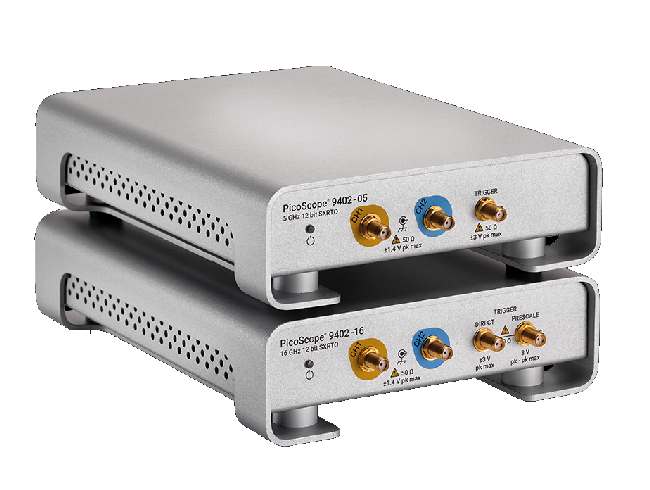 08 March 2021 - Pico Technology has added the PicoScope 9402-05 and 9402-16 two-channel models to their 5 GHz and 16 GHz SXRTOs. The new models join the 9404-05 and 9404-16 four-channel models launched last year. Ideally suited to repetitive or clock-derived signals, all models feature high-resolution 12-bit channels, each supported by real-time sampling to 500 MS/s per channel and up to 2.5 TS/s (0.4 ps) random equivalent-time sampling. These are voltage and timing resolutions that match or more typically exceed the best available amongst broadband real-time oscilloscopes today.
08 March 2021 - Pico Technology has added the PicoScope 9402-05 and 9402-16 two-channel models to their 5 GHz and 16 GHz SXRTOs. The new models join the 9404-05 and 9404-16 four-channel models launched last year. Ideally suited to repetitive or clock-derived signals, all models feature high-resolution 12-bit channels, each supported by real-time sampling to 500 MS/s per channel and up to 2.5 TS/s (0.4 ps) random equivalent-time sampling. These are voltage and timing resolutions that match or more typically exceed the best available amongst broadband real-time oscilloscopes today.
The wideband inputs, and fine timing and voltage resolutions, display and accurately measure transitions as fast as 22 ps and pulses and impulses down to 45 ps wide, and allow clock performance and eye diagram analysis of up to 10 Gb/s gigabit signals (to third harmonic). Less than 2 ps RMS trigger jitter and 5 GHz trigger bandwidth support margin analysis and characterization of today’s high-speed serial data systems, whilst optional integrated clock and data recovery to 8 Gb/s and an external prescaled trigger input extend the SXRTO trigger capability to the full bandwidth of the 16 GHz models. In addition, the real-time broadband sampling modes can support, for example, capture of carrier envelope, baseband modulation and other envelope tracking signals across major wireless communication frequency bands such as 900 MHz, 2.4 GHz and 5.5 GHz and upwards.
Pico’s SXRTO instrument architecture vastly reduces the cost of broadband time-domain sampling for repetitive signal or clock-related applications. Mark Ashcroft, RF Business Development Manager at Pico, points out that the principal cost drivers within the traditional real-time oscilloscope (RTO) are high data and memory bandwidths. High-speed real-time sampling requires data bandwidth far in excess of the analog system bandwidth and this drives up cost. In fact, constrained by cost, existing RTOs use ETS (random equivalent time sampling) to extend sampling density when repetitive signals are available. Pico’s new SXRTO architecture samples at a more cost-effective lower rate of 500 MS/s and instead develops the ETS technique to achieve market-leading sample rate multiplication of x5,000 to 2.5 TS/s. The vastly lower-cost SXRTO architecture recognizes that many high-bandwidth signals are or can be repetitive; allowing the expense of high (above Nyquist) sampling rate instruments to be avoided.
Comparing the SXRTO architecture with that of the sequential sampling oscilloscope, the SXRTO randomized ETS technique supports trigger and pre-trigger capture and the familiarity, convenience and ease of real-time oscilloscope operation. Pico’s SXRTO technology seamlessly transitions to single-event waveform capture at sampling rates at and below 500 MS/s and both sampling modes capture to memory of 250,000 samples (single channel); particularly valuable for the capture of slower system signals and modulation envelopes.
These USB-controlled instruments are supplied with PicoSample 4 software. The touch-compatible GUI controls the instrument and presents waveforms, measurements and statistics on your preferred size and format of display. There is full support for available Microsoft Windows display resolutions, allowing the inspection of waveform detail or presentation of measurements on HD to UHD monitors and projectors or across multiple monitors. Additionally, up to four independent zoomed trace views can fully reveal 12-bit, 250 kS waveform detail.
A wide range of automated and user-configurable signal integrity measurements, mathematics, statistical views and limits test facilities are included for validation and trending of pulse and timing performance, jitter, RZ and NRZ eye diagrams. Industry-standard communications mask tests such as PCIe, GB Ethernet and Serial ATA are included as standard.
While most users will run the PicoSample 4 software in their workplace, for OEM and custom applications the PicoScope 9400s can operate under ActiveX remote control. Programming examples are provided in Visual Basic (VB.NET), MATLAB and LabVIEW, but any programming language or standard that supports the Windows COM interface standard, including JavaScript and C, can be used.
PicoConnect 900 Series gigabit and microwave passive test probes are recommended for use with the PicoScope 9400 SXRTOs or indeed any 50 Ω broadband instrument. With typical residual tip capacitance of only 0.25 pF, these are the least invasive probes on the market and come with affordable range of bandwidths, division ratios and coupling types (AC and DC) out to 9 GHz. The PicoScope 9404 four-channel models have active SMA and LAN interfaces to support future configurations and networking.
Pricing
From the PicoScope 9402-05 two-channel 5 GHz model at $10,795 / €9,095 / £7,895 to the PicoScope 9404-16 at only $19,495 / €17,245 / £14,995. All models come with a comprehensive five-year warranty.

 How to resolve AdBlock issue?
How to resolve AdBlock issue? 